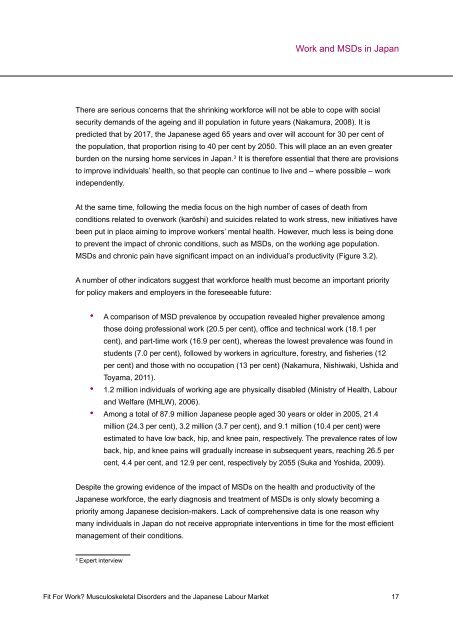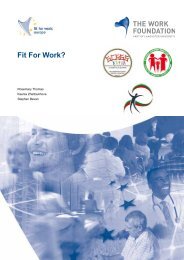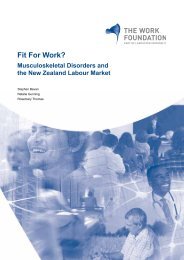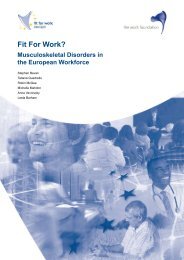English version - Fit for Work Europe
English version - Fit for Work Europe
English version - Fit for Work Europe
Create successful ePaper yourself
Turn your PDF publications into a flip-book with our unique Google optimized e-Paper software.
There are serious concerns that the shrinking work<strong>for</strong>ce will not be able to cope with social<br />
security demands of the ageing and ill population in future years (Nakamura, 2008). It is<br />
predicted that by 2017, the Japanese aged 65 years and over will account <strong>for</strong> 30 per cent of<br />
the population, that proportion rising to 40 per cent by 2050. This will place an an even greater<br />
burden on the nursing home services in Japan. 3 It is there<strong>for</strong>e essential that there are provisions<br />
to improve individuals’ health, so that people can continue to live and – where possible – work<br />
independently.<br />
At the same time, following the media focus on the high number of cases of death from<br />
conditions related to overwork (karōshi) and suicides related to work stress, new initiatives have<br />
been put in place aiming to improve workers’ mental health. However, much less is being done<br />
to prevent the impact of chronic conditions, such as MSDs, on the working age population.<br />
MSDs and chronic pain have significant impact on an individual’s productivity (Figure 3.2).<br />
A number of other indicators suggest that work<strong>for</strong>ce health must become an important priority<br />
<strong>for</strong> policy makers and employers in the <strong>for</strong>eseeable future:<br />
• A comparison of MSD prevalence by occupation revealed higher prevalence among<br />
those doing professional work (20.5 per cent), office and technical work (18.1 per<br />
cent), and part-time work (16.9 per cent), whereas the lowest prevalence was found in<br />
students (7.0 per cent), followed by workers in agriculture, <strong>for</strong>estry, and fisheries (12<br />
per cent) and those with no occupation (13 per cent) (Nakamura, Nishiwaki, Ushida and<br />
Toyama, 2011).<br />
• 1.2 million individuals of working age are physically disabled (Ministry of Health, Labour<br />
and Welfare (MHLW), 2006).<br />
• Among a total of 87.9 million Japanese people aged 30 years or older in 2005, 21.4<br />
million (24.3 per cent), 3.2 million (3.7 per cent), and 9.1 million (10.4 per cent) were<br />
estimated to have low back, hip, and knee pain, respectively. The prevalence rates of low<br />
back, hip, and knee pains will gradually increase in subsequent years, reaching 26.5 per<br />
cent, 4.4 per cent, and 12.9 per cent, respectively by 2055 (Suka and Yoshida, 2009).<br />
Despite the growing evidence of the impact of MSDs on the health and productivity of the<br />
Japanese work<strong>for</strong>ce, the early diagnosis and treatment of MSDs is only slowly becoming a<br />
priority among Japanese decision-makers. Lack of comprehensive data is one reason why<br />
many individuals in Japan do not receive appropriate interventions in time <strong>for</strong> the most efficient<br />
management of their conditions.<br />
3 Expert interview<br />
<strong>Work</strong> and MSDs in Japan<br />
<strong>Fit</strong> For <strong>Work</strong>? Musculoskeletal Disorders and the Japanese Labour Market 17







